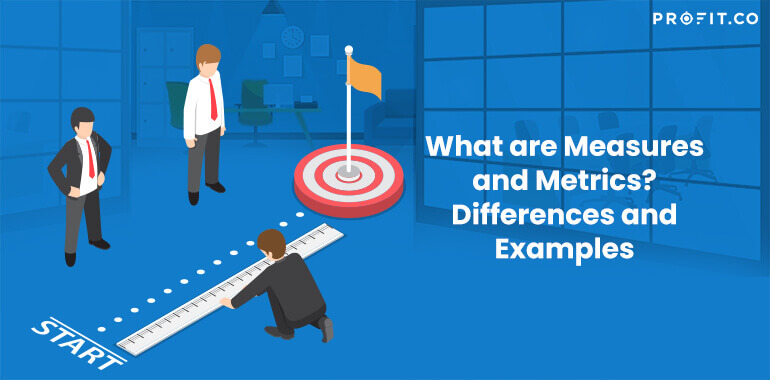Measures and metrics are easy to confuse because metrics are measures but with more significance. A measure is simply a figure, but metrics give this context. Both can provide valuable insights into how well your business is performing and where you should focus your efforts for improvement. By understanding these tools and learning when to use them, you can gain valuable insight into the health of your business.
Let’s explore measures and metrics as we highlight the key differences, discuss some examples, and find out how to track them.
What is a Measure?
A measure is a classification unit of raw data, like a value or number like length, volume, and area. Measures are typically used to quantify some size, quantity, or intensity. Measures help to assess individual elements within a more extensive system, such as employee productivity over a certain period.
Measures also help you identify areas to change to achieve your business goals. Still, they do not necessarily provide insight into why those changes should occur or how they will impact performance over time.
A useful metric is both accurate (in that it measure what it says it measures) and aligned with your goals.
Don’t measure anything unless the data helps you make a better decision or chnage your actions.
What is a Metric?
A metric is a measure you can quantify to monitor the progress and status of particular processes. Metrics determine the progress towards a certain goal by tracking specific data points over time.
They focus more on outcomes than inputs, providing quantitative evidence of improvement or decline over time which helps enhance the decision-making processes.
Metrics provide a more comprehensive assessment of how well your business is performing. You can use the metrics for predictive analysis to anticipate changes in the market or adjust strategies accordingly.

What is the Difference Between a Measure and a Metric?
Measures and metrics can provide invaluable insights into your business performance. By understanding these tools and learning when to use them appropriately, you can easily monitor the health of your business.
There are several critical differences between metric vs. measure, including
- Scope
The first difference between a measure and a metric is the scope. A measure generally looks at an individual element in a system, while metrics assess how well the entire system performs.
Although measures are fundamental units, they offer minimal information. Metrics combine measures and various data points so that the data tells a story. Metrics provide a way of quantifying the similarity or dissimilarity between data points.
For example, you can measure customer satisfaction with a particular service or product and use metrics to evaluate overall customer satisfaction across all services or products.
- Emphasis on performance versus outcomes
Measures focuses more on inputs such as allocated resources and activities performed, whereas metrics track progress toward desired results based on those inputs.
- Predictive analysis
Another distinction between metric vs. measure is that you can use metrics for predictive analysis. Key metrics provide data over time, which you can use to predict future performance. This is especially helpful for businesses that need to anticipate changes in the market or adjust their strategy.
Examples of Measures and Metrics
There are numerous examples of measures in almost any industry or organization.
Some examples include:
- How many happy customers are using your products and services
- How many website visitors last month
- The revenue that belongs to your company
- Response time for customer service inquiries
Measures are prevalent across industries because they provide valuable insights into business performance. Many numerical figures hold significance for businesses, as they serve as the foundation for their objectives. However, these numbers offer little value when viewed without context or background information.
Common examples of metrics include
- Customer satisfaction ratings over a period of time
- Employee productivity across a year
- Market share across the industry
- Response time for inquiries on different services
- Average wait times for phone support lines
- Completion rates on online orders across different quarters
- Average customer satisfaction score
All of these metrics provide valuable insights into how well your company is performing in different aspects of operations.
Metrics are valuable tools as they factor in past performance, which helps contextualize your current success or failure. Metrics promote a culture of continuous improvement by providing a way to track progress over time and identify areas for optimization.
For instance, if the response time when dealing with customer inquiries is excessively long, you may need to allocate more resources to accommodate those requests.
Tracking this metric over time gives you insight into the effectiveness of any changes and what you can do to improve customer experience further.
Metrics are also part of the strategy development processes to set specific goals and evaluate progress toward achieving them. You can establish targets related to profit margins that you want to achieve each quarter or the year-over-year growth rate you hope to accomplish by specific deadlines.
Tracking progress against these goals using appropriate measures informs decision-making regarding future investments or adjustments in current operations to reach the desired outcomes.
How to Use Measures and Metrics
Metrics and measures are powerful tools for evaluating performance and understanding where to make changes.
When should you use a measure?
In business, finding a one-size-fits-all solution to questions such as whether to use metrics or measures is rare. Your type of business will determine the best option between the two.
You can use measures to represent business-specific values such as the number of calls received, returned goods, website visits, and products sold. In manufacturing processes, you can use measures to track cycles, speed, and operating temperature.
When should you use a metric?
One key factor that affects when you should use metrics is the complexity of the problem you’re trying to solve. Suppose there are many moving parts involved or multiple variables affecting your desired outcome. In that case, collecting data on each one makes sense to identify better what needs improvement and determine if any adjustments were successful. One of the aspects of metrics is identifying SMART metrics that can measure the achievement of SMART goals. SMART stands for Specific, Measurable, Achievable, Relevant, and Time-bound. Organizations can benefit greatly from identifying and tracking these SMART metrics. Metrics, in general, and performance metrics in particular, are more beneficial if something needs constant feedback due to its dynamic nature.
Choosing the right measures and metrics
When choosing the right measures and metrics for a business, there are several important factors to consider. Firstly, your selected metrics or benchmarks should be relevant to your goals and objectives.
For example, if your primary goal is to increase profits, you should choose financial performance indicators like revenue growth rate rather than customer satisfaction. Depending on their dynamic nature, you should also consider how frequently specific measurements need re-evaluation.
Ultimately, having the right metrics and measurements ensures success within set timelines. KPIs (Key Performance Indicators) are a particular subset of metrics that are considered critical to the success of a business or organization. KPIs are selected based on their ability to measure progress toward achieving strategic goals and objectives. It also provides valuable insights into operational performance to inform decision-making. KPI Vs. Metrics is a debate that organizations continue to have. Both are important and serve different purposes within an organization.
Tracking Your Measures and Metrics
When tracking metrics and measures, the best methods will depend on the type of data you need to collect and analyze. For example, manual processes such as surveys may be suitable for qualitative information about customer experience. However, they could be more efficient for quantitative measurements like sales figures or financial performance indicators. In this case, automated tools like analytics software can help streamline the process and provide quick access to necessary data in a format that is easier to interpret.
FAQs
- What is the difference between a measure and a metric?
Although both use numerical values as their starting point, metrics contextualize these numbers by looking at long-term trends or relationships between different variables. Measures provide the raw data, while metrics look at patterns within this data to determine what you can improve or do differently.
- What are some examples of measures and metrics used in analytics?
Some common measures and metrics include revenue, profit margin, Customer Acquisition Cost (CAC), Return on Investment (ROI) and Customer Lifetime Value (CLV).
- How should you use measures and metrics effectively?
When using measures and metrics effectively, you must determine which metric or measure best suits your needs, whether this involves short-term analysis or long-term insight. The next step is selecting the most appropriate indicators based on the information you want to glean from the data set.
Once you collect the necessary measurements, you must analyze them and take action based on those results for meaningful improvements.
Conclusion
Metrics and measures can be handy tools for businesses. When deciding which one to use, you should consider factors such as the complexity of the problem, timeline constraints, and accuracy and relevance to the data you produce.
Any metrics or measures you choose should accurately reflect what they are supposed to quantify to gain actionable insights.
Lastly, different data types require varying tracking methods for accurate results. Innovative platforms and software provide a more efficient way of collecting quantitative information and visualizing and analyzing the data while generating updated reports.

Are you looking for a flexible OKR management tool to transparently track your KPIs and goals?


